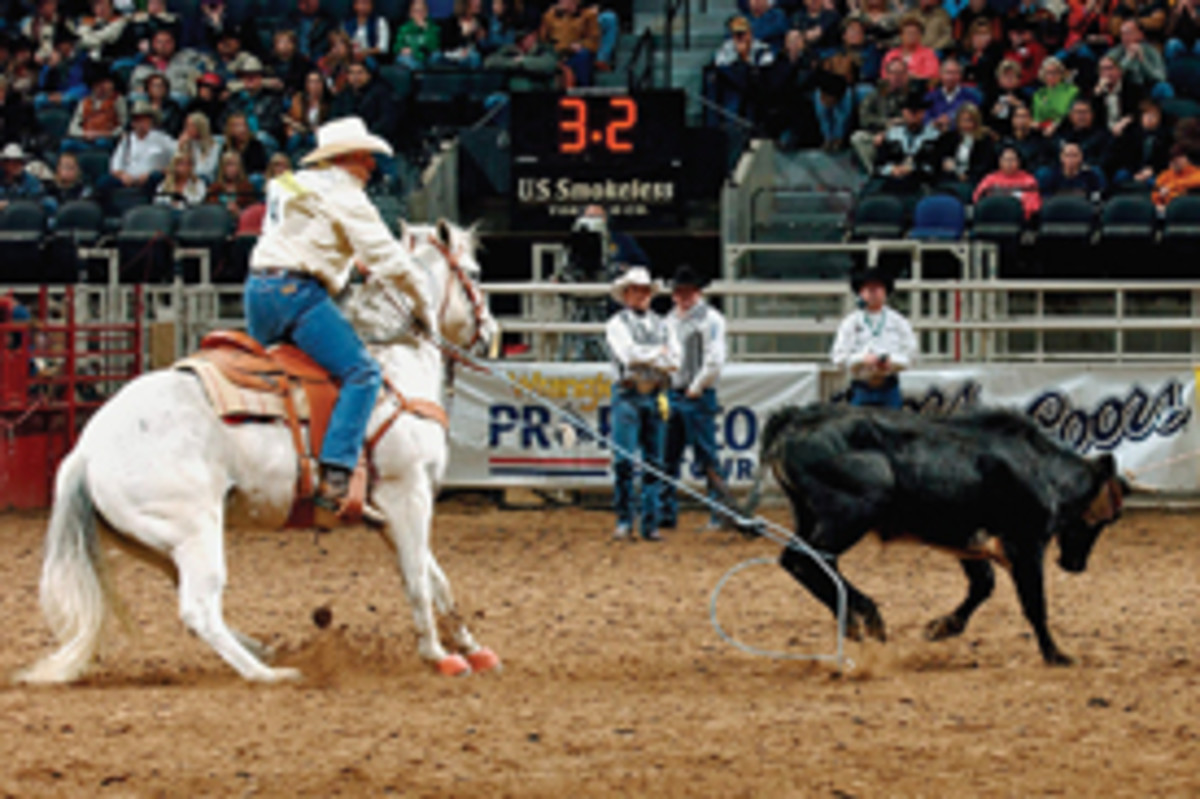
Wonder Horse
Dear Walt,
What makes a great heel horse? What should I be looking for?
Thanks,
Cole, Greenbrier, Ark.
Dear Cole,
We look for a horse that is broke. Broke in the body, broke in the poll, flexes, bends and knows his leads. We like a quiet horse that will lope in controlled circles. Those are the things we look for. For a guy who is a beginner or intermediate, that person should be looking for older horses. Horses that are proven, quiet and don’t buck. I like a horse that will pin his ears when he’s after the steer. I don’t like a horse to look terrified and have his head up in the air when he’s working.
Heeling Barrier
Dear Walt,
What can I do as a heeler to set the run up for my headers? At the rodeos and the local jackpots where there is no barrier on the heeler, I don’t seem to have as much trouble. But in town where the steers run hard and there is a heel barrier, I have a hard time helping my header.
Sincerely,
Dale, Ashdown, Ark.
Dear Dale,
When there’s a heeling barrier, all the heelers are in the same situation. But you do need to be able to look at the barrier and treat the barrier like the header. When the heading and heeling barrier are the same, that means you’re going to have to see a little more than tail to the pin. You don’t need to knock the barrier back, but you can’t give a three-foot lead because you’re afraid of the barrier. You need to understand that you need to be close, but not so close that you take a chance on breaking it. Then you have as good a chance as anyone. Like at the Wildfire Open, that heeling barrier was tail to the pin and the steers were drifting to the right. There’s nothing you could do about it. If your header can’t understand that, then you’re not communicating very well.
Better Stops
Dear Walt,
I am a heeler that has been roping for about four years and I was wondering how to get my horse to stop better when I throw my rope? I have tried many bits but none of them have shown the results I would like to see. What bit would you recommend?
Thanks for your time,
Brice, Yakima, Wash.
Dear Brice,
First of all, if the horse isn’t stopping, a lot of times it’s not the bit. It’s the fact that the horse isn’t broke very well. You might consider getting some help on horsemanship, whether it’s through videos or a school, to teach that horse how to stop properly. That horse needs to round his spine and use his hind end and not stop on his front feet. A lot of people think their heel horses don’t stop very well when they rope-well, they don’t stop very well period. So think about improving your horsemanship rather than just going to a bigger bit all the time.
Dally Fear
Dear Walt,
I’ve always been nervous about picking up my dallies, and ever since I saw that Jake Barnes lost his thumb, I’ve become even more nervous. I can usually catch two heels but I end up losing them. How do I calm my nerves and get my dally?
Alicia, Port Huron, MI
Dear Alicia,
A lot of times it has nothing to do with nerves. In our heeling video, we have five steps to dallying: lift, separate, slide, pop and dally. Most people think it’s just the dally-wrapping the rope around the saddle horn-and that’s not true. The reason you’re afraid to dally is because you probably don’t do it very well. If you ask Jake Barnes what happened, he’ll tell you he made a mistake. He roped the steer and felt his horse try to drop and he didn’t want to lose his rope so instead of kicking his horse back over there, he tried to dally and that’s why he got hurt. Jake teaches not to do that. The reason he got hurt is because he tries harder than anybody else in the world. A normal man would not have gotten hurt, but Jake wears a cape-he’s Superman-and he tried until the bitter end. So don’t think, ‘Just because Jake got hurt, I’m going to get hurt.’ We’ve all had close calls. You need to understand the mechanics of dallying and any good roping school will teach you proper dallying.
Bottom Strand Subtleties
Dear Walt,
I just went to a roping school and have been working on keeping my bottom strand down and leaving more rope on the ground. I can set a pretty good trap but I would like my bottom strand to go completely underneath. I was wondering what I can do when I am on the ground roping to help this in ropings.
Thank you,
Duston, Dumont, Iowa
Dear Duston,
This is really a hard question, because a lot of guys teach to jack the sawhorse up off the ground-I don’t do that. Putting the sawhorse on the ground and learning to let go of both pieces of rope at the same time will make your bottom strand hit the ground. I think the reason the bottom strand slides is because you don’t let go of both pieces at the same time or you lift up on the top strand of the rope when you deliver your rope before the right leg steps in it. On the sawhorse: put it on the ground, deliver your rope and don’t let the hand hold of your rope slide in front of the right leg. I want it to hit and stop-not slide.










